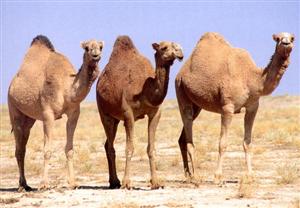Words of Wisdom from SharLeigh
Caravans of the (US) Desert
“Ships of the desert” sounds like an oxymoron, but it refers to camels. They glide across the sand with ease thanks to their cushioned feet that spread as they walk. Their two rows of eyelashes and the ability to close their nostrils completely protect them from sandstorms. A camel can travel for 18 hours, at 8-10 miles per hour, carrying 600 pounds. Camels are greatly prized in the vast deserts of the world. Movies have portrayed the scenario of the camel caravans of the Sahara Desert, but would you believe that there were camels here in the American deserts as well? In 1836, Major G.H. Crossman, an Army explorer of the West, recommended to Congress the use of camels in the deserts of the southwestern frontier. The desert did not have enough water or feed for a horse or mule. But a camel could brave these harsh conditions. By the 1840s it was getting very difficult to police and protect the frontier. During this time, wagon trains were forging through the wilderness and the Indians were not too happy about it. Calvary officers began to seriously consider the use of camels in the American deserts where grass and water were sparse. After much study, they chose the one hump camel or dromedary, an Arabian camel. It was conservative in its requirements of food and water and ideal for the harsh climates of the desert. By the 1850s, Congress appropriated $30,000 for 50 camels and enough funds to hire 10 camel drivers. April 1856 heralded the arrival of the camels and drivers. As the residents of Indianola, Texas watched the camels being unloaded, they probably thought that the circus had come to town. Camels were used in the West for mapping a route from Fort Defiance in Arizona to the Colorado River (part of US Highway 66) and assisted in building a portion of road known as the Butterfield Route. But as the Civil War erupted, the use of camels was suspended. Eventually, they were sold or let loose. Today, you may come across an old miner claiming to have seen a camel or two in the desert. And who knows, fact is always stranger than fiction!
Copyright
© 2006 10-4 Magazine and Tenfourmagazine.com
PO Box 7377 Huntington Beach, CA, 92615 tel. (714) 378-9990 fax
(714) 962-8506

